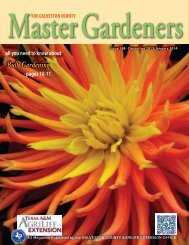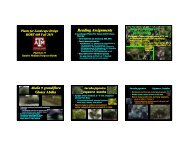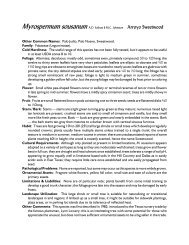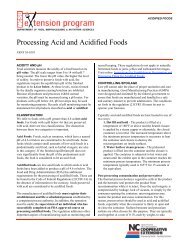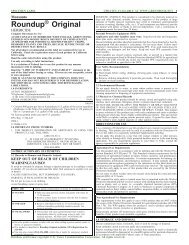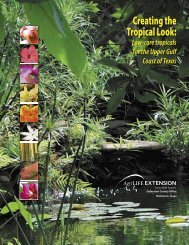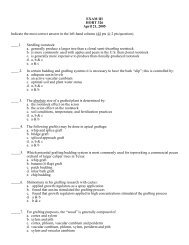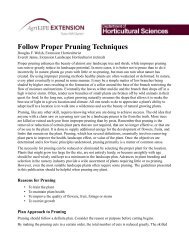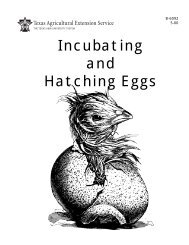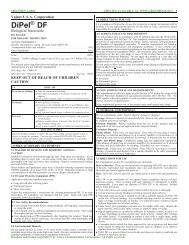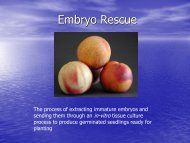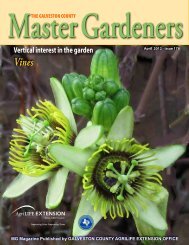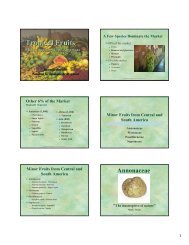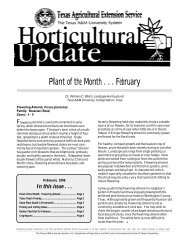Guide to PAS 2050 How to assess the carbon ... - Aggie Horticulture
Guide to PAS 2050 How to assess the carbon ... - Aggie Horticulture
Guide to PAS 2050 How to assess the carbon ... - Aggie Horticulture
Create successful ePaper yourself
Turn your PDF publications into a flip-book with our unique Google optimized e-Paper software.
14<br />
Section II: Calculating product <strong>carbon</strong> footprints<br />
Raw materials Manufacture Distribution/retail Consumer use Disposal/recycling<br />
] All inputs used<br />
] at any stage in<br />
] <strong>the</strong> life cycle<br />
] Include processes<br />
] related <strong>to</strong> raw:<br />
] materials<br />
] – Mining/<br />
] – extraction<br />
] – (minerals)<br />
] – Farming<br />
] – Forestry<br />
] – Pre-processing<br />
] – Packaging<br />
] – S<strong>to</strong>rage<br />
] – Transport<br />
] Account for<br />
] impact of raw<br />
] materials:<br />
] – Fertilisers<br />
] – (production,<br />
] – transport,<br />
] – application)<br />
] – Land use<br />
] – change<br />
] All activities<br />
] from collection<br />
] of raw materials<br />
] <strong>to</strong> distribution:<br />
] – All production<br />
] – processes<br />
] – Transport/<br />
] – s<strong>to</strong>rage<br />
] – related <strong>to</strong><br />
] – production<br />
] – Packaging<br />
] – Site-related<br />
] – emissions<br />
] – (e.g. lighting,<br />
] – ventilation,<br />
] – temperature)<br />
] All materials<br />
] produced:<br />
] – Product<br />
] – Waste<br />
] – Co-products<br />
] – (useful<br />
] – by-products)<br />
] – Direct emission<br />
] All steps in<br />
] transport and<br />
] related s<strong>to</strong>rage<br />
] Retail s<strong>to</strong>rage<br />
] and display<br />
] Energy required<br />
] during use<br />
] phase:<br />
] – S<strong>to</strong>rage<br />
] – Preparation<br />
] – Application<br />
] – Maintenance/<br />
] – repair (e.g. for<br />
] – long use<br />
] – phases)<br />
] All steps indisposal:<br />
] – Transport<br />
] – S<strong>to</strong>rage<br />
] – Processing<br />
] Energy required in<br />
] disposal/recycling<br />
] process<br />
] Direct emissions<br />
] due <strong>to</strong> disposal/<br />
] recycling:<br />
] – Carbon decay<br />
] – Methane release<br />
] – Incineration<br />
Common materials/activities <strong>to</strong> include within a product’s life cycle boundary<br />
The key principle for system boundaries is <strong>to</strong> include<br />
all ‘material’ emissions generated as a direct or indirect<br />
result of <strong>the</strong> chosen good or service being produced,<br />
used and disposed of or recycled.<br />
A material contribution is a contribution from any<br />
one source resulting in more than 1% of <strong>the</strong> <strong>to</strong>tal<br />
anticipated life cycle emissions of <strong>the</strong> product.<br />
<strong>PAS</strong> <strong>2050</strong> allows immaterial emissions <strong>to</strong> be<br />
excluded – any single source resulting in less than 1%<br />
of <strong>to</strong>tal emissions. <strong>How</strong>ever, <strong>the</strong> <strong>to</strong>tal proportion of<br />
immaterial emission sources cannot exceed 5% of <strong>the</strong><br />
full product <strong>carbon</strong> footprint. Detailed specifications of<br />
<strong>the</strong> boundaries are described in <strong>PAS</strong> <strong>2050</strong> Section 6.<br />
For fur<strong>the</strong>r detail on inclusions and exclusions, see<br />
Step 4: Calculating <strong>the</strong> footprint.<br />
Boundaries: what not <strong>to</strong> include<br />
• Immaterial emissions sources (less than 1% of <strong>to</strong>tal<br />
footprint)<br />
• Human inputs <strong>to</strong> processes<br />
• Transport of consumers <strong>to</strong> retail outlets<br />
• Animals providing transport (e.g. farm animals used<br />
in agriculture or mining in developing countries)<br />
Materiality and prioritisation<br />
To decide whe<strong>the</strong>r an emission source is likely <strong>to</strong> be<br />
material, it helps at this point <strong>to</strong> do a high-level<br />
footprint analysis using estimates and readily<br />
accessible data (see Step 3: Collecting data for<br />
guidance on potential sources). This analysis includes<br />
<strong>the</strong> full life cycle of <strong>the</strong> product but relies on estimates



